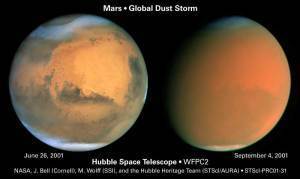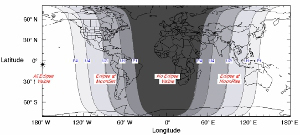Kate Rauner's Blog, page 86
May 2, 2015
On the Wheel of Life
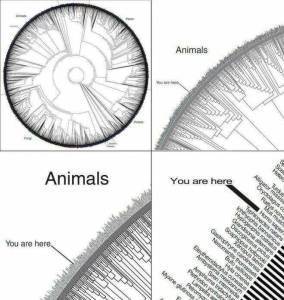 I love this diagram – the old “tree” design doesn’t hold all of life in a handy format, so this wheel is becoming popular. Some people find the wheel disturbing or even offensive – they think it says humanity is insignificant. Not so. Among all those species, we are unique. Among billions of humans, you are unique. What could be more amazing or more significant than that? As one of my favorite poems says, “You are a child of the universe no less than the trees and the stars; you have a right to be here. And whether or not it is clear to you, no doubt the universe is unfolding as it should.”
I love this diagram – the old “tree” design doesn’t hold all of life in a handy format, so this wheel is becoming popular. Some people find the wheel disturbing or even offensive – they think it says humanity is insignificant. Not so. Among all those species, we are unique. Among billions of humans, you are unique. What could be more amazing or more significant than that? As one of my favorite poems says, “You are a child of the universe no less than the trees and the stars; you have a right to be here. And whether or not it is clear to you, no doubt the universe is unfolding as it should.”
One little spoke on an immense wheel, and we’re a species that can change the world, made of individuals who can seek and strive in ways that reach across the globe and beyond the planet. That’s significant.








April 29, 2015
One Step Closer to a Wooly Mammoth
 Researchers at Harvard extracted DNA from a wooly mammoth preserved in Arctic permafrost, copied fourteen genes related to its adaptation to cold, and inserted them into Asian elephant skin cells. Hurray – the cells continued to function normally – in a petri dish.
Researchers at Harvard extracted DNA from a wooly mammoth preserved in Arctic permafrost, copied fourteen genes related to its adaptation to cold, and inserted them into Asian elephant skin cells. Hurray – the cells continued to function normally – in a petri dish.
I’ve thought that bringing back the mammoth would be a stunt – immensely cool, but a stunt nonetheless. Elephants, the mammoth’s surviving relative, are intelligent animals with a complex social life. They care for one another and teach their offspring. Perhaps a mammoth infant could be adopted by a herd of elephants, and I’d definitely take a trip to see such a baby, but would it really be a mammoth in the full sense of body and behavior?
It turns out there’s a practical intermediate step possible with this research. Mammoths have a number of adaptations to cold, including hairiness, ear size, subcutaneous fat and differences in their hemoglobin. Scientists hope, eventually, to “raise hybrid elephants that could be genetically wired to thrive in colder climes — hopefully expanding their range to live at a greater remove from humans.” So resurrected mammoth DNA may help save their endangered modern cousins.
But no one can resist the thought of herds of mammoths roaming the Earth again. “The team might even try to bring back the woolly mammoth itself.”
Not everyone favors de-extinction for the wooly mammoth, in part for fear that modern elephants would be harmed in the research process or for fear of monstrous creations.
Current efforts at rewilding, recreating the lost ecosystem of the Pleistocene, meet with similar concerns – isn’t it a big enough challenge to protect the animals alive today without trying to reconstruct the past? Rewilding advocates call for existing species to be reintroduced where their ancestors once roamed – we’re trying to save grizzly bears and condors already, and horses returned to America with European conquest long ago. Rewilding would repopulate the American high plains and mountain west with cheetahs, lions, llamas, tortoises, related plant species, and – yes – elephants. With global warming underway, I doubt the Pleistocene can be recreated in the United States – maybe Canada or Siberia? Or maybe it’s a romantic dream.
Some say any available funds should go to preserving existing threatened species, but I think lack of political will is a bigger obstacle than lack of money. Perhaps retrieving animals from extinction would create public interest and dedication to save other species. I certainly want to see any research conducted ethically, but given that… wooly mammoths. It’s hard to resist the idea. What a thrill that would be.
Many outlets covered the Harvard work; for example: discovery.com is quoted above, or try Popular Science
Kate Rauner, Hanover, New Mexico, USA
Kate is a chemical and environmental engineer, and Cold War Warrior (honestly, that’s what Congress called us), who worked in America’s nuclear weapons complex. Now retired on the edge of the southwest’s Gila National Forest with her husband, cats, llamas, and dog, she fights fire as a volunteer and writes science fiction novels and science inspired poetry. She also shares science news that strikes her fancy (and finds it odd to write about herself in the third person.)








April 25, 2015
Rival to Mermaids’ Song – a poem by Kate Rauner

Earth’s larger strings of ocean ridges.
Earth pulsates with her endless song,
Notes drawn out and much prolonged.
A seismic tune beyond our ears,
Yet never does it disappear.
Vibrations roll in gentle swells
To ring the Earth, a massive bell.
Wavelengths too long to feel,
Beyond our senses chime and peal.
Deep ocean waves rake and strum
Where strings of seafloor ridges run.
Bow to Earth’s violin,
Meditative hum within.
We humans live no more aware
Of Earth’s deep song than of the air.
“A new study… explains Earth’s mysterious, never-ending hum,” which is too faint and low for us to hear. Some animals, for example elephants, hear or feel well below the human range, so perhaps the Earth sings them lullabies.
http://www.livescience.com/50473-earth-mysterious-hum-explained.html?google_editors_picks=true
http://en.wikipedia.org/wiki/Microseism








April 22, 2015
Warm Pacific Blob – a poem by Kate Rauner
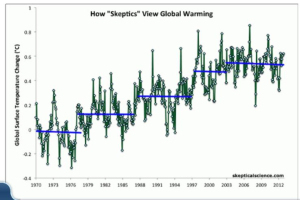
The PDO may explain why global warming occurs in a stair-step pattern.
Pacific
Decadal
Oscillation
Is one of Earth’s great dances,
On downswing curb’s the water’s warmth,
On upswing it enhances.
A subtle giant warms or cools
The vast Pacific surface,
Moves ocean fish and salmon runs
With deep water’s reemergence.
It stirs the clouds and shifts the winds
Wide across the globe,
A pattern in the monthly flux that
Centuries of tree rings hold.
There’s something odd a-happening
Off America’s western coast,
Earth’s wobble spanning decades
Has swallowed warming’s dose.
But what goes cool must then reverse,
The escalator rise.
Droughts will damage farmland
And coral reefs will die.
Salt water will flood coastal zones,
Extinction rates will climb.
These are the precious coins with which
We’ve bought our modern lives.
The Pacific Decadal Oscillation is one of many natural cycles on Earth which interplay with climate. It’s a recent discovery made while studying salmon runs in the North American west: “Over the past century, the amplitude of this climate pattern has varied irregularly at interannual-to-interdecadal time scales… This climate pattern also affects coastal sea and continental surface air temperatures.” Surface temperatures often receive the attention in global warming discussions, though the whole-Earth temperature may be more important.
A “warm blob” is forming in the northeast Pacific Ocean that may represent a change in the PDO, “with one NOAA researcher saying, ‘when you see something like this that���s totally new you have opportunities to learn things you were never expecting.’���
There are many sources for information on global warming, the resulting climate change, and the PDO. Here are a few:
skepticalscience.com
washingtonpost.com/the-pacific-ocean
washingtonpost.com/news/energy-environment
http://en.wikipedia.org/wiki/Pacific_decadal_oscillation
commondreams.org-mass-die-250-million-years-ago








April 15, 2015
We’ll Find We’re Not Alone – a poem by Kate Rauner
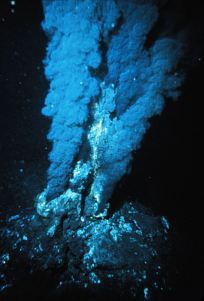
Hydrothermal vents are able to support extremophile bacteria on Earth and may also support life in other parts of the cosmos.
We will find we’re not alone,
The proof is at our finger tips.
We have the means, robotic craft
Extend our touch on epic trips.
We know where round the Sun to look,
Know how to search for traces.
Moons and planets wait for us,
Within our reach are many places.
No wormholes, warping space required,
No need for hyperdrives.
Technology is here today
To find unearthly lives.
With chemistries like ours – or strange,
Not likely grays or bug-eyed men,
Expected small, but bodies huge
Are not beyond imagining.
Mars only lost his oceans
A million years ago.
Solar winds stripped air away,
And with it, oceans go.
But liquid water blankets
Some moons of Jupiter.
Beneath their crusts of ice,
Hordes of life may stir.
To feed on broth by magma brewed
May be an easy strategy.
Get energy not from the Sun,
But twisted tides of gravity.
Ganymede,
Europa,
And Callisto,
Or methane lakes on Titan,
Life free from H2O.
Geysers may toss microbes high,
Bouquets to passing hands,
Till we can pierce a mile of ice
To meet them in their lands.
To find that life is commonplace
Will not diminish me,
But will expand my mind and soul
And all that I can be.
“I believe we are going to have strong indications of life beyond Earth in the next decade and definitive evidence in the next 10 to 20 years,” Ellen Stofan, chief scientist for NASA, said at a public panel Tuesday in Washington. “We know where to look, we know how to look, and in most cases we have the technology.” latimes.com
That would be amazing, astounding, awesome… and that’s just the “a” words I can think of. Extraterrestrial life is discussed in many places, for example, solarsystem.nasa.gov , jpl.nasa.gov , or wikipedia extraterrestrial life
For me, even a real microbe will be better than all the movies put together – reality always trumps fantasy.








April 11, 2015
Happy Tax Day
 If you’re an American, you pay your federal income tax next week, or at least apply for an extension. (You did remember, didn’t you?)
If you’re an American, you pay your federal income tax next week, or at least apply for an extension. (You did remember, didn’t you?)
Some Americans pay a high tax rate – we call it a heavy tax. But it’s not as heavy as a real estate tax in ancient Egypt. “A recently translated ancient Egyptian tax receipt [date corresponds to July 22, 98 B.C.] shows a bill that is (literally) heavier than any American taxpayer will pay this year ��� more than 220 lbs. (100 kilograms) of coins… ‘It’s an incredibly large sum of money,’ said Brice Jones… who translated the text. ‘These Egyptians were most likely very wealthy.'” Their tax bill was about thirty times a contemporary laborer’s annual salary.
The tax bill included an extra charge levied because the payment was made in bronze rather than silver coins, so the number and weight of coins was heavier. The pharaoh’s tax collectors had to “absorb the cost of transport and handling. In cases where [they] had to bring in a big load, it was packed in baskets and carried by donkeys.”
I wonder if some ancient Egyptian millionaire paid in bronze to show anger at the tax. In today’s world, some people pay in pennies to encourage thrift or protest the bill, but businesses are not required to accept pennies.
I hope your tax bill doesn’t break the bank or your donkey’s your back.








April 8, 2015
Hellas a Crater – a poem by Kate Rauner
The largest impact crater seen,
The largest that we’ve found,
Could not exist on gaseous worlds,
It’s gouged in rocky ground
The Hellas Basin’s found on Mars,
From crater rim to dusty floor,
Nine thousand meters is its depth,
The height that airplanes soar.
The basin sits at antipode
To enormous shield volcanoes
That rise upon the Tharsis Bulge,
Punched right through the globe.
Dust emerges from its depths,
Storm after storm a’ chasing,
Enveloping and planet wide,
It should be called Hell’s Basin.
I’m working on a novel about colonizing Mars, and dust will be a huge problem. The Hellas Basin is known for its dust storms.








April 3, 2015
“Blood Moon” is a silly term, but lunar eclipses are fun
Will you be able to see the total lunar eclipse tomorrow? “Blood Moon” is a silly media term – the moon will look more rusty or even gray – coppery at its best. But still fun to see.
The best view is from the Pacific Ocean. If you insist on a large landmass, in eastern Australia or western US and Canada the moon rises or sets at totality. There will also be webcasts, watch the total lunar eclipse webcast on Space.com or the online Slooh community observatory at slooh.com.
“It’s no surprise that this lunar eclipse is coming so close on the heels of a solar eclipse. Solar eclipses can occur only when the moon is at a “node” in its orbit. (The nodes are the two points where the moon’s path on the sky crosses the sun’s path, which is called the ecliptic.)
“During the March 20 solar eclipse, the moon crossed the ecliptic from north to south and cast its shadow on the Earth. On Saturday, a half orbit later, the moon will cross the opposite node from south to north, becoming engulfed in Earth’s shadow.”
You may wonder why there isn’t an eclipse every month. Well, orbits aren’t perfect circles and planets and moons don’t lie perfectly in the same solar system plane. The cosmos ignores our human obsession with ‘neat and tidy’.
More at space.com

April 1, 2015
Don’t Blame the Moon – a poem by Kate Rauner
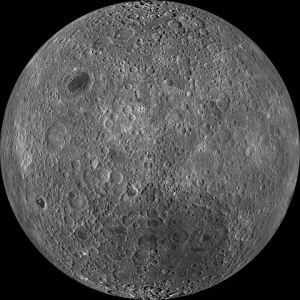
Far side of the Moon is no more “dark” than the “far side” of the Earth
Murder rates and crashing cars,
Assassinations, brawls in bars,
Crisis calls to the police,
Births, or walking in your sleep,
Domestic violence, suicides,
Assaults and kidnappings besides,
Payout rates in gambling halls,
Accidents, trips and falls,
Gunshots, stabbings, kicks and bites,
Hockey players’ on-ice fights,
Psychiatric admissions,
Vexed emergency room physicians.
It’s not the moon, new or full.
Phases of the moon are due
To alignment with the Earth and Sun.
It doesn’t make you love or shun
Or manipulate anyone.
This is one of the most popular things we all know that ain’t so. Folklore that the full moon affects human behavior is deeply imbedded in our culture, a bit of romantic frippery.
Beware of confirmation bias. “We have a tendency to interpret information in a way that confirms our beliefs and to ignore data that contradict our beliefs. What are the facts? Review all the evidence, especially the evidence that seems to refute your beliefs.” Good advice for any topic.
More at:
wikipedia
doubtfulnews.com
ucla.edu
skepdic.com
csicop.org
For more Moon folklore (some of it true): snopes.com

March 28, 2015
Self-Driving Cars – Coming to Your Highway in June
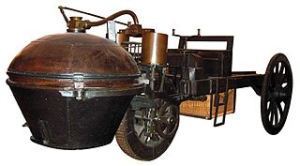
Steam powered car from 1771
I included self driving cars in my science fiction novel, Glitch. That book is supposed to be a vision of the future, but I’m barely ahead regarding cars. (They should be called self-driving, not driverless – something is driving and it’s a combination of hardware and software created by human beings.)
“All Teslas will get an over-the-air update this summer, probably around June, allowing them to drive in ‘Autopilot’ mode… we’re not talking about some far-off future Tesla. We’re not talking about Google driverless car prototypes or government road tests. This is a car you can buy today, which will be given the ability to drive itself in a few months via the same setup that updates your iPhone.” mashable
Not only will self-driving cars allow me to read or nap or whatever as I travel, they should also make car-sharing easier. Imagine a computer system moving cars around for maximum efficiency and minimum wait-times. Private car ownership will decline, and that will change America. The automobile industry is a pillar of our economy, and the car is a pillar of our culture. Your driver’s license means leaving childhood behind, offers freedom, and you never forget your first car. Losing your driver’s license is more than inconvenient, it’s shameful. All that’s about to change.
The self-driving car is a change I’m looking forward to – I can imagine exactly how it will improve my life. Since nothing is perfect, there are probably problems coming, too. Bring it on.
“The past is a foreign country: they do things differently there.” That applies to the future, too.
Kate Rauner, Hanover, New Mexico, USA
Kate is a chemical and environmental engineer, and Cold War Warrior (honestly, that’s what Congress called us), who worked in America’s nuclear weapons complex. Now retired on the edge of the southwest’s Gila National Forest with her husband, cats, llamas, and dog, she’s a volunteer firefighter, and writes science fiction novels and science inspired poetry. She also shares science news that strikes her fancy (and finds it odd to write about herself in the third person.)


